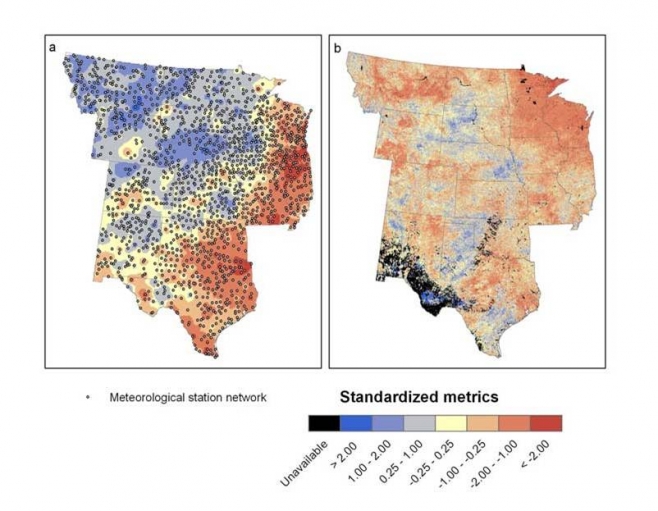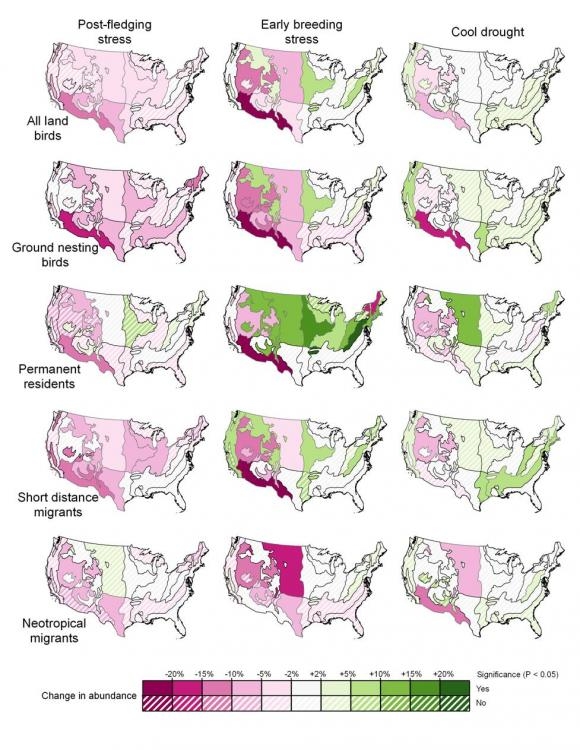Posted 08/9/10
Climate change alters weather patterns, globally and regionally, and in many places this will entail more frequent extreme weather events such as heatwaves and droughts. To investigate their effect on bird abundance and diversity, SILVIS researcher Tom Albright combined records from the North American Breeding Bird Survey with precipitation records and temperature data from NASA satellites. Albright found that bird species abundance can decline as much as 30% after droughts and heatwaves and that changes are strongest for uncommon bird species.
We are living in a changing world, and so does wildlife. Current climate change not only increases mean temperatures, but also affects the global and continental distribution of extreme weather events, says Tom Albright, a postdoctoral researcher at the SILVIS lab at the University of Wisconsin-Madison. Change in weather patterns can expose areas to increases in extreme events such as heatwaves and droughts, which in turn may affect wildlife such as birds. Having a background in physical geography as well as ecology, and strong skills in remote sensing, Tom Albright thought that was an exciting and important issue to address. Combining records from the North American Breeding Bird Survey with precipitation records and temperature data from NASA satellites, Albright analyzed changes in avian abundance and community diversity in relation to the occurrence of heatwaves and droughts in the conterminous United States. ‘The North American Breeding Bird Survey data set is amazing’, tells Albright ,’bird watchers, as citizen-scientists, make a big effort and check bird presence by visiting the same road-side transects at the same time of the year, year after year – and the data go back as far 1960s’.

Analyzing precipitation and temperature records with respect to deviation from standardized values in a given area, Albright and co-authors found that bird species abundance declines by as much as 30% after droughts and heatwaves. To focus on the immediate effects, Albright analyzed bird abundance the same or following year of changed precipitation and temperature. ‘Precipitation and temperature is of course correlated – if it is hot, it becomes drier. In spite of this correlation, analyzing the combination of these factors is valuable to me, giving more information than one factor alone’, says Albright.

Most interestingly and importantly, the historic records analyzed by Albright and co-authors pinpointed the greatest changes in bird abundance and diversity in areas that are predicted by regional climate models to experience the most extreme future change in weather such as heatwaves and droughts. ‘This overlap is very interesting, but also gives reason of concern’, says Albright. As the time window of high temperature and low precipitation increases, birds and other wildlife are more likely to reach their physiological limits of resilience. To untangle the influence of common bird species on the observed patterns, Albright and co-authors looked specifically how common and uncommon species responded to heatwaves and droughts, and found that the responses are even larger for the uncommon ones. ‘Apart from seeing a clear and distinct response, we still have insufficient knowledge about whether the observed changes in bird abundance and diversity are due to alteration in demographic or migratory parameters or others’. But that is another story and a new project – Albright will move to Nevada to start an assisted professor position in Ecoclimatology. Good luck and we are looking forward to hear more about extreme weathers and their ecological effects.”
Story by Wiebke Neumann
